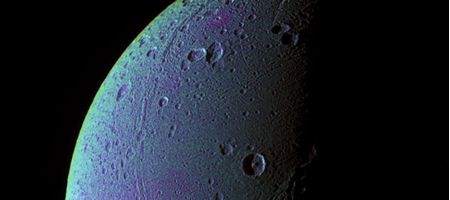Observations from NASA’s Cassini spacecraft have revealed an oxygen atmosphere around Saturn’s moon Dione.

Los Alamos National Laboratory scientists and an international research team say they’ve discovered the molecular oxygen ions in the moon’s upper-most atmosphere.
As a result of the findings, the team suspects that all the moons surrounding Saturn and Jupiter could have atmospheres that include oxygen.
What really excites them is the possibility that on a moon with subsurface water, such as Jupiter’s moon Europa, molecular oxygen could combine with carbon in subsurface lakes to form the building blocks of life.
Dione – one of Saturn’s 62 known moons – orbits the planet at roughly the same distance as our own moon orbits Earth. Just 700 miles wide, it appears to consist of a thick, pockmarked layer of water ice surrounding a smaller rock core.
As it orbits Saturn every 2.7 days, Dione is bombarded by ions emanating from Saturn’s very strong magnetosphere. These ions slam into the surface of Dione, displacing molecular oxygen ions into Dione’s thin atmosphere through a process called sputtering.
The molecular oxygen ions are then stripped from Dione’s exosphere by Saturn’s strong magnetosphere.
The ions were detected by the Cassini Plasma Spectrometer (CAPS) during a flyby of the moon in 2010. Los Alamos researchers Robert Tokar and Michelle Thomsen noted the presence of the oxygen ions.
“The concentration of oxygen in Dione’s atmosphere is roughly similar to what you would find in Earth’s atmosphere at an altitude of about 300 miles,” says Los Alamos researcher Robert Tokar.
“It’s not enough to sustain life, but – together with similar observations of other moons around Saturn and Jupiter – these are definitive examples of a process by which a lot of oxygen can be produced in icy celestial bodies that are bombarded by charged particles or photons from the Sun or whatever light source happens to be nearby.”






